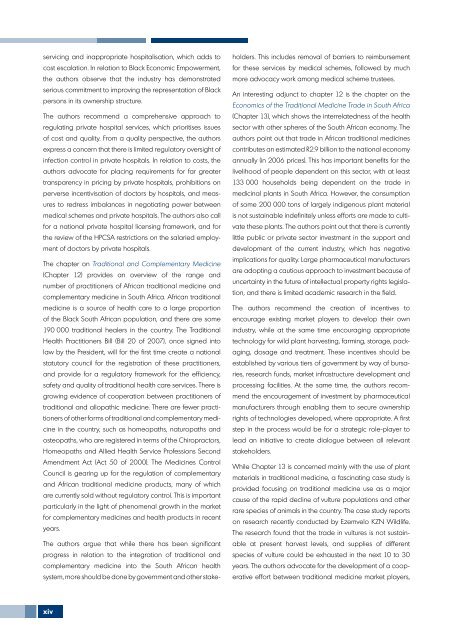SAHR 2007 - Health Systems Trust
SAHR 2007 - Health Systems Trust
SAHR 2007 - Health Systems Trust
Create successful ePaper yourself
Turn your PDF publications into a flip-book with our unique Google optimized e-Paper software.
servicing and inappropriate hospitalisation, which adds to<br />
cost escalation. In relation to Black Economic Empowerment,<br />
the authors observe that the industry has demonstrated<br />
serious commitment to improving the representation of black<br />
persons in its ownership structure.<br />
The authors recommend a comprehensive approach to<br />
regulating private hospital services, which prioritises issues<br />
of cost and quality. From a quality perspective, the authors<br />
express a concern that there is limited regulatory oversight of<br />
infection control in private hospitals. In relation to costs, the<br />
authors advocate for placing requirements for far greater<br />
transparency in pricing by private hospitals, prohibitions on<br />
perverse incentivisation of doctors by hospitals, and measures<br />
to redress imbalances in negotiating power between<br />
medical schemes and private hospitals. The authors also call<br />
for a national private hospital licensing framework, and for<br />
the review of the HPCSA restrictions on the salaried employment<br />
of doctors by private hospitals.<br />
The chapter on Traditional and Complementary Medicine<br />
(Chapter 12) provides an overview of the range and<br />
number of practitioners of African traditional medicine and<br />
complementary medicine in South Africa. African traditional<br />
medicine is a source of health care to a large proportion<br />
of the black South African population, and there are some<br />
190 000 traditional healers in the country. The Traditional<br />
<strong>Health</strong> Practitioners Bill (Bill 20 of <strong>2007</strong>), once signed into<br />
law by the President, will for the first time create a national<br />
statutory council for the registration of these practitioners,<br />
and provide for a regulatory framework for the efficiency,<br />
safety and quality of traditional health care services. There is<br />
growing evidence of cooperation between practitioners of<br />
traditional and allopathic medicine. There are fewer practitioners<br />
of other forms of traditional and complementary medicine<br />
in the country, such as homeopaths, naturopaths and<br />
osteopaths, who are registered in terms of the Chiropractors,<br />
Homeopaths and Allied <strong>Health</strong> Service Professions Second<br />
Amendment Act (Act 50 of 2000). The Medicines Control<br />
Council is gearing up for the regulation of complementary<br />
and African traditional medicine products, many of which<br />
are currently sold without regulatory control. This is important<br />
particularly in the light of phenomenal growth in the market<br />
for complementary medicines and health products in recent<br />
years.<br />
The authors argue that while there has been significant<br />
progress in relation to the integration of traditional and<br />
complementary medicine into the South African health<br />
system, more should be done by government and other stakeholders.<br />
This includes removal of barriers to reimbursement<br />
for these services by medical schemes, followed by much<br />
more advocacy work among medical scheme trustees.<br />
An interesting adjunct to chapter 12 is the chapter on the<br />
Economics of the Traditional Medicine Trade in South Africa<br />
(Chapter 13), which shows the interrelatedness of the health<br />
sector with other spheres of the South African economy. The<br />
authors point out that trade in African traditional medicines<br />
contributes an estimated R2.9 billion to the national economy<br />
annually (in 2006 prices). This has important benefits for the<br />
livelihood of people dependent on this sector, with at least<br />
133 000 households being dependent on the trade in<br />
medicinal plants in South Africa. However, the consumption<br />
of some 200 000 tons of largely indigenous plant material<br />
is not sustainable indefinitely unless efforts are made to cultivate<br />
these plants. The authors point out that there is currently<br />
little public or private sector investment in the support and<br />
development of the current industry, which has negative<br />
implications for quality. Large pharmaceutical manufacturers<br />
are adopting a cautious approach to investment because of<br />
uncertainty in the future of intellectual property rights legislation,<br />
and there is limited academic research in the field.<br />
The authors recommend the creation of incentives to<br />
encourage existing market players to develop their own<br />
industry, while at the same time encouraging appropriate<br />
technology for wild plant harvesting, farming, storage, packaging,<br />
dosage and treatment. These incentives should be<br />
established by various tiers of government by way of bursaries,<br />
research funds, market infrastructure development and<br />
processing facilities. At the same time, the authors recommend<br />
the encouragement of investment by pharmaceutical<br />
manufacturers through enabling them to secure ownership<br />
rights of technologies developed, where appropriate. A first<br />
step in the process would be for a strategic role-player to<br />
lead an initiative to create dialogue between all relevant<br />
stakeholders.<br />
While Chapter 13 is concerned mainly with the use of plant<br />
materials in traditional medicine, a fascinating case study is<br />
provided focusing on traditional medicine use as a major<br />
cause of the rapid decline of vulture populations and other<br />
rare species of animals in the country. The case study reports<br />
on research recently conducted by Ezemvelo KZN Wildlife.<br />
The research found that the trade in vultures is not sustainable<br />
at present harvest levels, and supplies of different<br />
species of vulture could be exhausted in the next 10 to 30<br />
years. The authors advocate for the development of a cooperative<br />
effort between traditional medicine market players,<br />
xiv
















